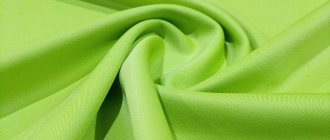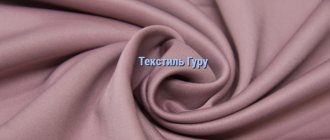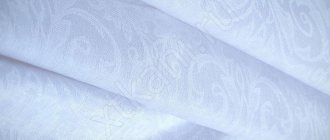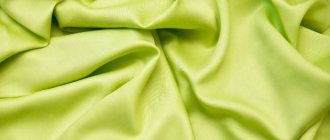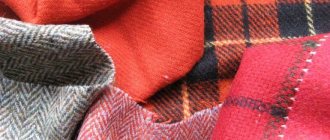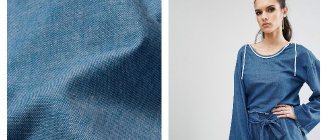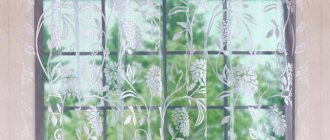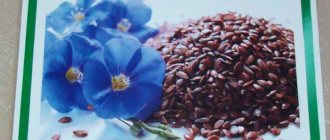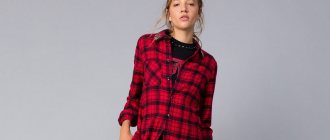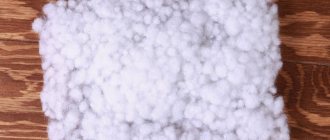Cotton is a fabric made from natural cotton fibers. It is extremely popular and in demand not only due to its high consumer characteristics, but also due to the wide variety of species.
The main advantages of this fabric are naturalness, breathability and hypoallergenicity. The area of application of cotton is wide; it is actively used in sewing clothes, household accessories, and furniture upholstery. Special filters for industrial production and dressing materials for the medical field are made from cotton.
What is cotton
“Cotton” is translated from English as “cotton” and denotes the international name for a well-known natural fabric obtained from plant raw materials - cotton. To be more precise, cotton is the name of a large group of fabrics, united by the fact that cotton is the main raw material in their production. Cotton clothing with the word “cotton” on the label can be found in almost everyone’s possessions – T-shirts, towels, bed linen and underwear, jeans, dresses, and children’s clothes.
In fact, cotton is cotton. Although the textile industry knows many of its types, in the production of which they use not only pure cotton (the main raw material), but also other fibers and synthetic additives. Due to this, cotton fabrics with different properties are obtained. For example, satin, poplin, chintz, calico, cambric, flannel, flannel - all this is cotton.
History of fabric
People learned to cultivate cotton, process and use its fibers in everyday life, and sew clothes from it long ago. Many thousands of years ago. This is evidenced by the mummies of pharaohs found during excavations, wrapped in half-decayed cotton fabric, or the remains of cotton textiles in the burials of the ancient Mayans.
Cotton fabrics came to Europe much later. The precious linen, which was brought to European countries by Arab merchants, was literally worth its weight in gold. By the 15th century, clothing made from cotton began to replace items made from linen and wool.
Production technology
To obtain fabric from large cotton flowers, you first need to wait until they bloom and a boll forms on the stem, inside which the main wealth is contained - fibers with seeds, from which, after processing, they will be made into cloth.
Ripe bolls of valuable cotton varieties are harvested by hand. But mainly cotton harvesters are used for this. After going through several production and technological processing cycles, the fibers turn into the starting material.
Cleaning
Cotton fibers are cleaned of debris and seeds and sorted by length. The short ones are used to make cotton wool, and only the long fibers are used to produce fabric.
Spinning
Threads are obtained from isolated fibers.
Sizing
To make threads and yarn stronger, they are treated with a special solution.
Receiving the canvas
Using various methods of weaving threads, fabric is produced on a loom.
Whitening
Unbleached finished fabric of a dirty gray hue is bleached by treating with various chlorides or hydrogen peroxide.
Coloring
More than 4,000 coloring pigments are used for this.
Cleaning
Finally, the cotton is chemically cleaned to remove used adhesives. It again acquires its original properties.
Mercerization
To give cotton materials valuable consumer properties, they are immersed in a special solution. This processing method makes the fabric silky, and the fabric is better dyed.
If you go through all these stages manually, the processing process is quite difficult and lengthy. This is probably why cotton fabric was expensive at first. The appearance of spinning machines in 1730, the cultivation of cotton on large areas in countries with warm climates (Uzbekistan, Brazil, America, Turkey, Mexico, China), changes in production technology greatly increased the production of cotton fabric. The material has become accessible and cheap.
conclusions
- Cotton is described as a material made from natural cotton (not a single percentage of synthetics).
- The production process includes many technological operations: from collecting boxes to dyeing the finished canvas.
- Natural fabric has a lot of useful properties: hygroscopicity, breathability, strength, comfort to wear and hypoallergenicity.
- Cotton is the English word for cotton, and denim remains the most popular cotton fabric.
- Caring for fabric requires avoiding concentrated chemicals and chlorine-containing bleaches. Requires gentle washing in a washing machine.
Description and properties
Cotton is a variety of cotton-based fabrics that differ in:
- weaving method: twill, satin, satin, plain;
- using single-strand (less durable fabric) or double-strand yarn (increases wear resistance and strength);
- finishing and processing technologies;
- tightness of threads.
The technology used in weaving for a certain type of fabric determines the density of the material. Cotton fabrics are light in density - up to 100 g/m2, medium - up to 200 g/m2, heavy - more than 200 g/m2.
Cotton fiber composition consists of 90% plant cellulose, 5% water, 0.5% other components.
In the production of linen, not only cotton fibers are used. To give the fabric properties such as wrinkle resistance and increase its strength, viscose and synthetic threads (spandex, elastane, lycra) are added to the composition.
Cotton fibers are easily dyed - fabrics are produced with various patterns or in plain colors.
The porous, breathable structure of cotton fabric absorbs moisture well - an important quality when sewing summer clothes. Lightweight cotton fibers retain heat well.
Composition, general characteristics
The basis of the fiber fabric is 95% cellulose, which provides them with relative strength. The remaining 5% are impurities in the form of minerals and fats. After numerous treatments, the individual fibers are spun into yarn for bobbins on looms.
The classification of cotton is extensive, as it includes fabrics that differ in:
- method of weaving fibers;
- the density of their contact with each other in the canvas;
- subsequent processing of the material.
Characteristics and properties of fabric
Density depends on weaving technology. It interacts well with dyes and does not cause any difficulties when washing.
The reason for the popularity of cotton fabric
Advantages and disadvantages
After analyzing the properties of this fabric and consumer reviews, we have compiled a list of its advantages and disadvantages.
Pros:
- Easy care. Cotton items can be washed frequently; some types of fabric can even be boiled and bleached if necessary. They are easy to iron.
- Availability. Cotton products are sold in many stores in big cities and small villages. And for the price, many people are satisfied with the fabric.
- Hypoallergenic. 100% natural fiber material does not cause allergies and does not irritate the skin.
- Hygroscopicity. Clothing made from natural fiber, which “breathes” and wicks away moisture well, makes it easy to withstand the heat.
- Strength and wear resistance.
Minuses:
- Cotton wrinkles a lot and doesn't stretch well - soft cotton fabric needs to be ironed after each wash.
- Shrinks when washed if the fibers are not treated with special products. Therefore, some people prefer cotton with the addition of synthetic impurities. For example, stretch cotton, not 100% cotton.
- The material quickly fades, loses color after washing and under the influence of ultraviolet radiation.
How to make sure that the fabric is natural
This can be understood by color and some external features.
Due to the dyeing of the canvas in its finished form, the fabric may be dyed unevenly, and the pattern does not lie evenly everywhere. Compared to viscose, with which cotton is often confused, in the first option the structure of the fabric when dyed is perfectly even.
When wet, cotton, unlike viscose, which swells greatly, practically does not change its structure. In addition, wet cotton fabric becomes very durable.
Another common method that is often used when checking fabric for authenticity is to pull out a couple of threads from the fabric and set it on fire. Natural fiber burns quickly and does not melt, unlike synthetics, turning into light ash. You may smell the smell of burnt paper.
Story
- The suitability of cotton for creating fabrics was known even before our era. The conclusions are made on the basis of preserved information about the life of the Mexican Indians (3-5 thousand BC), the ancient Persians (5th century BC), and the inhabitants of the Indus civilization (5 thousand BC).
- Before the invention of an automated system for removing the fibrous contents of the plant from seeds, cotton fabric was very expensive due to the labor-intensive manual process. Technological progress has reduced the processing speed of one bale of basic raw materials by 50 times and amounted to 12 hours.
Types of fabric
The mark “100% cotton” on the clothing tag indicates that the natural material is made entirely from cotton. But we cannot always visually determine what type of fabric it is. Because there are a lot of varieties of materials in which cotton is added.
In addition to purely cotton fabrics (calico, chintz, satin, corduroy, flannel, cambric, poplin), there are fabrics that contain synthetics. Depending on the ratio of natural and artificial threads in the composition, on the method of weaving and the thickness of the threads, new fabrics with new properties are obtained.
Stretch cotton
Natural fabric with the addition of synthetic elastic fibers (5% elastane, lycra or spandex). This composition improves the properties of matter.
Clothing made from stretch cotton does not wrinkle, does not stretch or shrink after washing, is easy to iron, and dries quickly. At the same time, its hygienic properties remain as high as in fabric without synthetics. Women's clothing is often made from stretch cotton, which stretches well.
Satin-cotton
Double-sided thick fabric with a smooth glossy front side and matte back side.
Satin-cotton
Due to the weaving technology and shiny silky outer side, the fabric resembles satin. The inside is densely dull, like cotton fabrics.
Memory (polished cotton)
The fabric with a shiny surface contains 70% polyester and 30% cotton. Durable fabric practically does not wrinkle, is waterproof, drapes well, and is breathable. The fabric is premium.
Polycotton
Wear-resistant beautiful material, which contains 35% polyester and 65% cotton. Durable, elastic, high-quality fabric that hardly wrinkles is often used when sewing home textiles and bed linen.
Microcotton
Fabric with a high degree of hygroscopicity is made from rare varieties of cotton. Luxury home textiles are made from it.
Denim-cotton
Thick cotton fabric popular in the textile market.
To increase elasticity, elastane and other synthetic fibers are added to it. The result is different types of denim.
Software
Mixed fabric with a cotton content of no more than 20%. It is made using a special weaving technology from thin threads.
Linen cotton
Hygroscopic, comfortable to wear material - soft and heavy at the same time.
A little synthetic is added to the composition so that the fabric wrinkles less.
Supercotton
Thick cotton fabric made from premium quality yarn. With a shiny, silky surface thanks to mercerization technology. Clothes made from it are easy to wash. Smoothes out only at high temperatures. Bed linen is made from it.
Viscose with added cotton fibers
This composition improves the characteristics of the source material, making viscose denser and more durable.
Baby (kids) cotton
It is soft, hypoallergenic, hygienic and has low wear resistance. It is used to make clothes for children.
Weary
Hypoallergenic natural fabric with an admixture of elastane, from which elastic underwear is sewn.
Knitted cotton jersey
In most cases, synthetic fibers are added to its composition, which maintain the shape of the product in good condition after washing, wearing, and ironing.
100% cotton is a natural fabric or synthetic,
Cotton is a material based on natural raw materials - cotton. This fabric is environmentally friendly and can be used by children and allergy sufferers. Varieties of cotton may contain various additives, including artificial ones, so before purchasing you should familiarize yourself with the composition of the fabric.
One hundred percent cotton on the label means that the material from which the product is made is absolutely natural, without impurities or additives.
How is cotton different from cotton?
“Cotton” – in Russia, “cotton” – in other countries of the world. Both names, which indicate more about the characteristics of the composition than the type of material, are identical and correct. In fact, there are no significant differences between them. Unless there are some nuances in technological processes. In terms of properties and characteristics, they are equivalent to each other.
Cotton, which contains cotton fibers, just like cotton, is a natural material. This means breathable, hypoallergenic, durable, comfortable to wear in hot weather. And its disadvantages are about the same: the fabric is inelastic, shrinks, quickly fades under the influence of ultraviolet radiation, and wrinkles a lot.
This is typical for fabrics whose label states that they are 100% cotton. Absolutely natural without any additives or impurities. But, as we have already seen, there are many varieties of cotton. And not all of them are made from 100% cotton. Some contain artificial and synthetic fibers. That’s why it’s so important to familiarize yourself with the composition of the fabric before purchasing.
Advantages of cotton fabrics:
- strength;
- heat resistance;
- high hygroscopicity (quickly absorb moisture);
- breathability (eliminates the greenhouse effect when worn);
- hypoallergenic (subject to compliance with the technology for purifying residual impurities of herbicides, bleaches and the use of high-quality dyes);
- do not deform when in contact with moderately aggressive alkalis.
Minuses:
- poor elasticity (poor stretch);
- shrinks (wash only in warm water);
- susceptibility:
a) to UV rays (color fades, white turns yellow);
b) to citric acid (with prolonged exposure, strength is lost).
- Putrefactive processes quickly begin with prolonged contact with water;
- thick canvases take a long time to dry after getting wet;
- With 100% cotton content, the material wrinkles easily.
Application of fabric
The consumer properties of cotton made from natural cotton fibers are so high that not only clothes are sewn from it. It is used as a filler for bedding, for dressings in medicine, in household appliances and the food industry as filters.
Although, of course, most of the fabrics are still used for sewing T-shirts, dresses, pajamas, home suits, children's clothes, daily and outerwear, furniture covers, and home textiles.
Manufacturer country
According to Russian legislation, the country of origin of the product must always be indicated on the label. Information about the manufacturer is also in the barcode. Today, the most widely used barcoding systems are the American system (UPC) and the European coding system (EAN). The UPC barcode consists of 12 digits, and the EAN barcode consists of 13. According to the EAN code, the first two digits indicate the country of origin of the product, the next five indicate the manufacturer, another five indicate the name of the product, its consumer properties, dimensions, weight, color. The last digit is used to check that the scanner is reading the strokes correctly.
Care instructions
The nuances of proper washing
Cotton fabric is easy to care for. Therefore, things made from it, without fear of spoiling something, can be washed in a machine. The main rule is to choose the right temperature. For tips on what temperature to wash this or that product, look on the label. Usually there are also hint icons for choosing a washing mode.
Why should this be done? Because the properties of things made of cotton, seemingly the same for all types of fabric, can be different. It depends on the composition, density, color of the material.
Before washing, items must be sorted into colored and white. Place heavily soiled and stained clothing and textiles separately. Select a washing mode. Hang washed and wrung clothes on hangers or a dryer, straightened out, in the shade so that the material does not fade.
If necessary, clothes made from colored thin fabrics can be washed by hand or at temperatures up to 40 degrees on a delicate cycle.
For washing, you can use any powders and gels.
How to iron
Cotton items look very wrinkled after washing. Ironing them is not difficult, but it is better not to overdry things. If this happens, a hot iron (190-200 degrees) with steam or pre-moistening the fabric will correct the situation.
Large duvet covers, tablecloths, sheets are ironed when folded from different sides. Clothes with embroidery and decorative inserts are ironed from the inside out.
If there is an unwashed stain left on the clothing, it is better not to iron the item, but to try to wash it again or in some other way to get rid of the stain. If you iron it, it will be difficult to get rid of the stain.
If the cotton contains synthetics, ironing must be done strictly at the temperature indicated on the label.
So, we found out that “cotton” is the name not of any individual fabric, but of a large group of cotton materials. It can include both completely natural materials made from 100% cotton, and mixed materials containing synthetic additives in one quantity or another in addition to cotton fibers. All cotton fabrics have common properties. However, there are differences that should be taken into account when choosing and caring for fabric.
